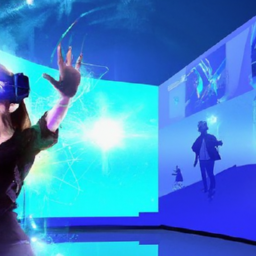The Role of AR and VR in Immersive Marketing
Marketing has always been about creating experiences that capture the attention of consumers and engage them in a meaningful way. With the advancement of technology, marketers now have access to exciting tools like Augmented Reality (AR) and Virtual Reality (VR) to create even more immersive marketing experiences.
What is AR?
AR is a technology that overlays digital information, such as images, videos, or animations, onto the real world. It uses your smartphone or tablet’s camera and screen to blend digital content with the physical world. In the context of marketing, AR allows brands to create interactive and engaging experiences by adding a virtual layer to their products or physical spaces.
How does AR enhance marketing experiences?
AR can be a game-changer for marketers, as it allows them to provide consumers with a more interactive and personalized experience. Let’s say you’re walking down the street and pass by a store with a digital sign advertising a new product. With AR, you can use your smartphone to scan the sign and instantly see a virtual model of the product, try different colors, or even see how it would look in your home. This not only grabs your attention but also allows you to engage with the product in a way that was previously not possible.
Another example of AR in marketing is the use of virtual try-on. Many cosmetic and fashion brands now offer AR apps that enable customers to virtually try on makeup, glasses, or clothing before making a purchase. This not only saves time, but also helps customers make more informed decisions and boosts their confidence in their choices.
What is VR?
VR is a technology that creates a completely immersive digital environment, usually through the use of a VR headset. It transports users to a virtual world where they can interact with objects, people, and scenarios that feel real. In marketing, VR can be used to create memorable and impactful experiences that leave a lasting impression on consumers.
How does VR enhance marketing experiences?
VR takes marketing experiences to a whole new level by fully immersing consumers in a virtual world. Imagine being transported to a luxury resort through the power of VR. You can explore the beautiful surroundings, take a virtual tour of the rooms, and even experience the excitement of various activities. This not only gives consumers a taste of what they can expect but also triggers their emotions and desires in a way that traditional marketing methods cannot.
VR can also be used to provide virtual product demonstrations or create interactive storytelling experiences. For example, a car manufacturer can allow potential customers to experience a virtual test drive, giving them a realistic sense of the vehicle’s features and performance. This level of interaction and engagement helps brands build stronger connections with their audiences and increase brand loyalty.
The Future of AR and VR in Marketing
The applications of AR and VR in marketing are constantly evolving and expanding. As technology continues to advance, we can expect even more innovative uses of these tools. Imagine being able to virtually attend a fashion show, try on clothes in a virtual fitting room, or even have virtual conversations with influencers or brand ambassadors.
AR and VR have the potential to revolutionize the way we experience marketing. By creating immersive and interactive experiences, brands can captivate consumers in a way that traditional advertising methods cannot. So, be prepared to see more AR filters on social media, AR shopping experiences, and VR activations in the near future. The possibilities are truly endless!


